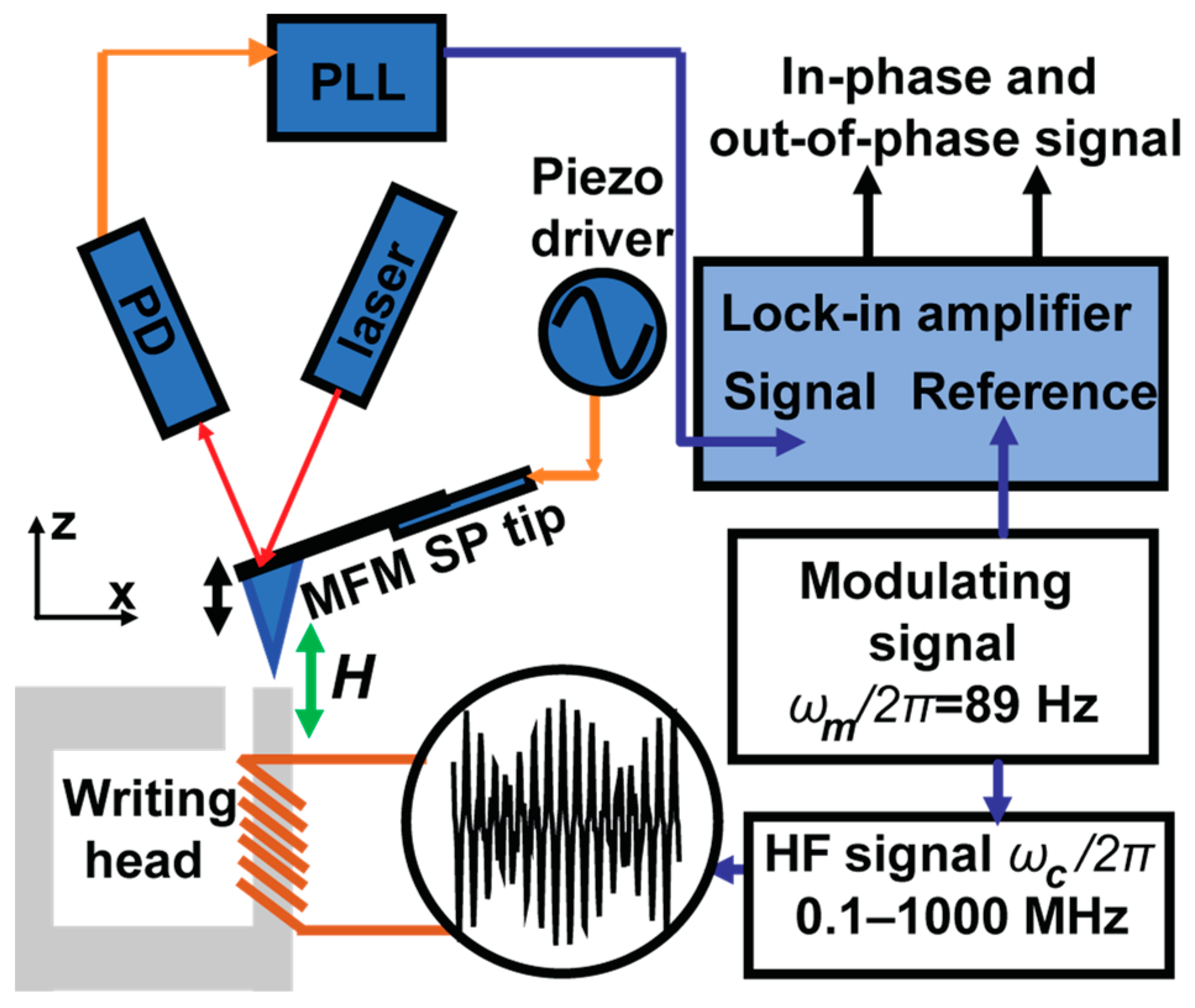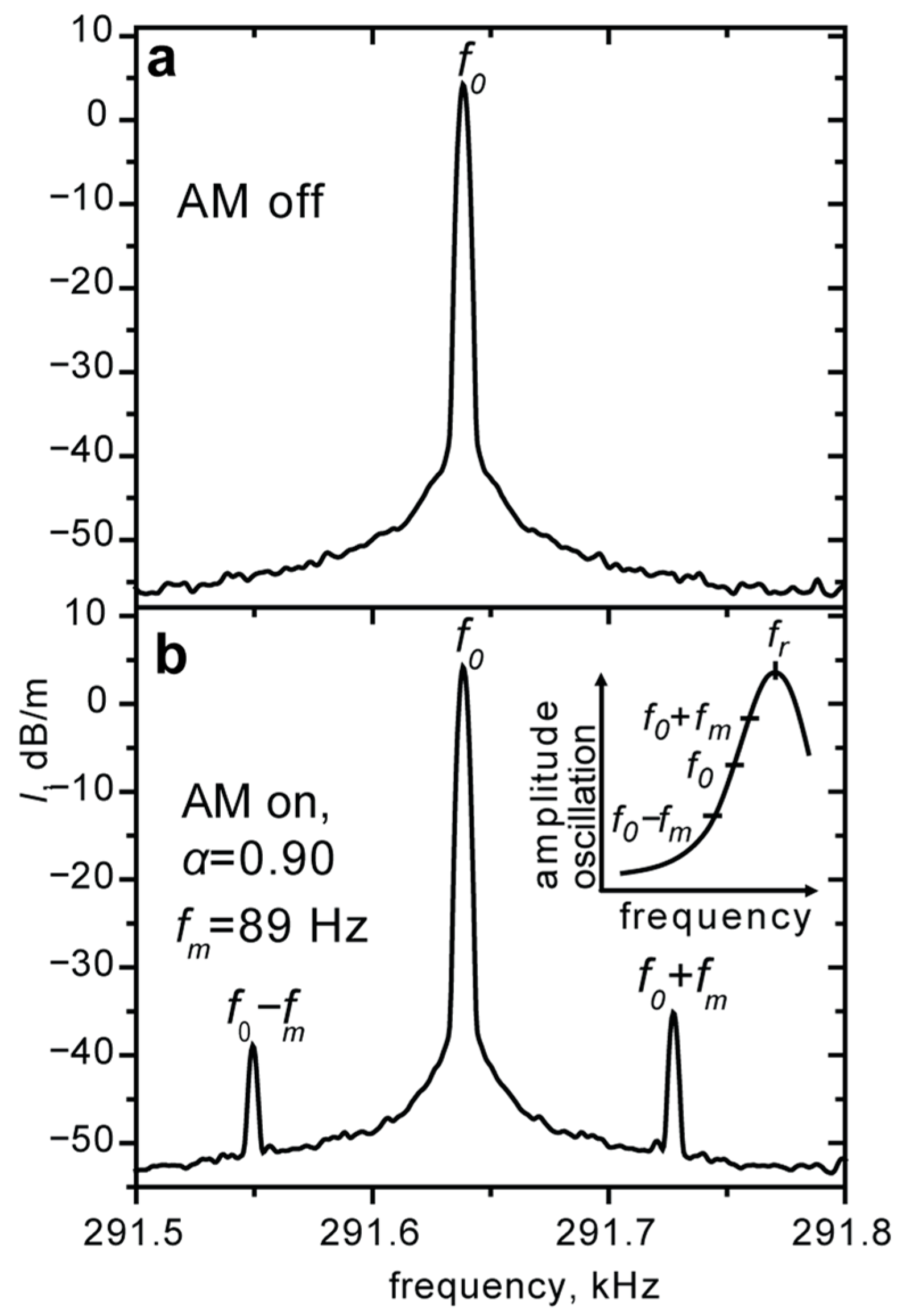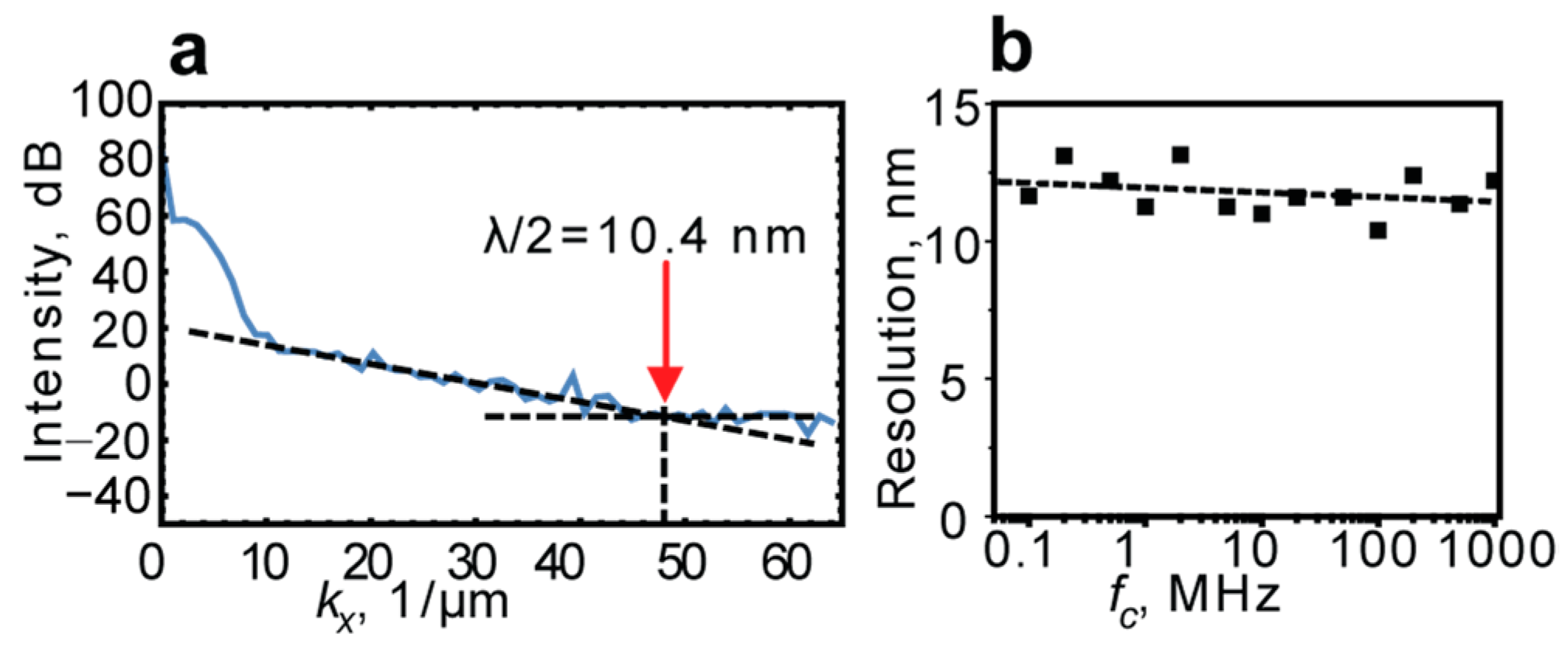High-Frequency Magnetic Field Energy Imaging of Magnetic Recording Head by Alternating Magnetic Force Microscopy (A-MFM) with Superparamagnetic Tip
Abstract
1. Introduction
2. Materials and Methods
3. Results and Discussion
4. Conclusions
Author Contributions
Funding
Institutional Review Board Statement
Informed Consent Statement
Data Availability Statement
Acknowledgments
Conflicts of Interest
References
- Saito, H.; Lu, W.; Hatakeyama, K.; Egawa, G.; Yoshimura, S. High frequency magnetic field imaging by frequency modulated magnetic force microscopy. J. Appl. Phys. 2010, 107, 09D309. [Google Scholar] [CrossRef]
- Makarova, M.V.; Akaishi, Y.; Ikarashi, T.; Rao, K.S.; Yoshimura, S.; Saito, H. Alternating Magnetic Force Microscopy: Effect of Si doping on the temporal performance degradation of amorphous FeCoB magnetic tips. J. Magn. Magn. Mater. 2019, 471, 209–214. [Google Scholar] [CrossRef]
- Makarova, M.V.; Akaishi, Y.; Suzuki, Y.; Rao, K.S.; Yoshimura, S.; Saito, H. High-resolution alternating magnetic force microscopy using an amorphous FeB-based tip driven by an inverse magnetostrictive effect: Imaging of the high-density magnetic recording media. J. Magn. Magn. Mater. 2022, 546, 168755. [Google Scholar] [CrossRef]
- Kumar, P.; Suzuki, Y.; Cao, Y.; Yoshimura, S.; Saito, H. High resolution magnetic field energy imaging of the magnetic recording head by A-MFM with Co-GdOx super-paramagnetic tip. Appl. Phys. Lett. 2017, 111, 183105. [Google Scholar] [CrossRef]
- Kumar, P.; Cao, Y.; Suzuki, Y.; Yoshimura, S.; Saito, H. Magnetic energy flow imaging of magnetic recording head with enhanced resolution and sensitivity by A-MFM using high magnetic moment superparamagnetic tip. J. Appl. Phys. 2018, 123, 214503. [Google Scholar] [CrossRef]
- Cao, Y.; Kumar, P.; Zhao, Y.; Suzuki, Y.; Yoshimura, S.; Saito, H. High magnetization Co-GdOx superparamagnetic granular films as magnetic coating materials for high-sensitivity alternating magnetic force microscopy tip. J. Magn. Magn. Mater. 2018, 462, 119–126. [Google Scholar] [CrossRef]
- Hasegawa, D.; Yang, H.; Ogawa, T.; Takahashi, M. Challenge of ultra high frequency limit of permeability for magnetic nanoparticle assembly with organic polymer—Application of superparamagnetism. J. Magn. Magn. Mater. 2009, 321, 746–749. [Google Scholar] [CrossRef]
- Balaev, D.A.; Stolyarc, S.V.; Knyazev, Y.V.; Yaroslavtsev, R.N.; Pankrats, A.I.; Vorotynov, A.M.; Krasikov, A.A.; Velikanov, D.A.; Bayukov, O.A.; Ladygina, V.P.; et al. Role of the surface effects and interparticle magnetic interactions in the temperature evolution of magnetic resonance spectra of ferrihydrite nanoparticle ensembles. Results Phys. 2022, 35, 105340. [Google Scholar] [CrossRef]
- Sadat, M.E.; Bud’ko, S.L.; Ewing, R.C.; Xu, H.; Pauletti, G.M.; Mast, D.B.; Shi, D. Effect of dipole interactions on blocking temperature and relaxation dynamics of superparamagnetic iron-oxide (Fe3O4) nanoparticle systems. Materials 2023, 16, 496. [Google Scholar] [CrossRef]
- Slay, D.; Cao, D.; Ferré, E.C.; Charilaou, M. Ferromagnetic resonance of superparamagnetic nanoparticles: The effect of dipole–dipole interactions. J. Appl. Phys. 2021, 130, 113902. [Google Scholar] [CrossRef]
- Song, N.N.; Yang, H.T.; Liu, H.L.; Ren, X.; Ding, H.F.; Zhang, X.Q.; Cheng, Z.H. Exceeding natural resonance frequency limit of monodisperse Fe3O4 nanoparticles via superparamagnetic relaxation. Sci. Rep. 2013, 3, 3161. [Google Scholar] [CrossRef]
- Liu, F.H.; Shi, S.; Wang, J.; Chen, Y.; Stoev, K.; Leal, L.; Saha, R.; Tong, H.C.; Dey, S.; Nojaba, M. Magnetic recording at a data rate of one gigabit per second. IEEE Trans. Magn. 2001, 37, 613–618. [Google Scholar] [CrossRef]
- Kaiser, D.; Dakroub, H.; van der Schans, A.; Haftek, E.; Li, S.; Zhu, W.; Pro, J.; Vorasarn, K.; Stankiewick, A.; Cox, R.; et al. Evaluation of high data rate disk drive recording subsystem. J. Appl. Phys. 2003, 93, 6555. [Google Scholar] [CrossRef]
- Hsu, W.-H.; Victora, R.H. Heat-assisted magnetic recording—Micromagnetic modeling of recording media and areal density: A review. J. Magn. Magn. Mater. 2022, 563, 169973. [Google Scholar] [CrossRef]
- Takagishi, M.; Narita, N.; Nakagawa, Y.; Nagasawa, T.; Osamura, R.; Maeda, T.; Yamada, K. Microwave assisted magnetic recording: Physics and application to hard disk drives. J. Magn. Magn. Mater. 2022, 563, 169859. [Google Scholar] [CrossRef]
- Ohkoshi, S.; Yoshikiyo, M.; Imoto, K.; Nakagawa, K.; Namai, A.; Tokoro, H.; Yahagi, Y.; Takeuchi, K.; Jia, F.; Miyashita, S.; et al. Magnetic pole flip by millimeter wave. Adv. Mater. 2020, 32, 2004897. [Google Scholar] [CrossRef]
- Valkass, R.A.J.; Spicer, T.M.; Burgos Parra, E.; Hicken, R.J.; Bashir, M.A.; Gubbins, M.A.; Czoschke, P.J.; Lopusnik, R. Time-resolved scanning Kerr microscopy of flux beam formation in hard disk write heads. J. Appl. Phys. 2016, 119, 233903. [Google Scholar] [CrossRef]
- Mitin, D.; Grobis, M.; Albrecht, M. Scanning magnetoresistive microscopy: An advanced characterization tool for magnetic nanosystems. Rev. Sci. Instrum. 2016, 87, 023703. [Google Scholar] [CrossRef]
- Czoschke, P.; Kaka, S.; Gokemeijer, N.J.; Franzen, S. Real-time direct measurement of field rise time and dynamic instability of perpendicular writers. Appl. Phys. Lett. 2010, 97, 242504. [Google Scholar] [CrossRef]
- Einsle, J.F.; Gatel, C.; Masseboeuf, A.; Cours, R.; Bashir, M.A.; Gubbins, M.; Bowman, R.M.; Snoeck, E. In situ electron holography of the dynamic magnetic field emanating from a hard-disk drive writer. Nano Res. 2015, 8, 1241–1249. [Google Scholar] [CrossRef]
- Goto, T.; Jeong, J.S.; Xia, W.; Akase, Z.; Shindo, D.; Hirata, K. Electron holography of magnetic field generated by a magnetic recording head. Microscopy 2013, 62, 383–389. [Google Scholar] [CrossRef] [PubMed]
- Suto, H.; Kikitsu, A.; Kotani, Y.; Maeda, T.; Toyoki, K.; Osawa, H.; Kikuchi, N.; Okamoto, S.; Nakamura, T. Time-resolved imaging of an operating hard-disk-drive write head using nano-beam x-ray magnetic circular dichroism. J. Appl. Phys. 2020, 128, 133903. [Google Scholar] [CrossRef]
- Li, S.; Lin, E.; George, Z.; Terrill, D.; Mendez, H.; Santucci, J.; Yie, D. Methods for characterizing magnetic footprints of perpendicular magnetic recording writer heads. J. Appl. Phys. 2014, 115, 17B733. [Google Scholar] [CrossRef] [PubMed]
- Tanaka, S.; Azuma, Y.; Majima, Y. Secondary resonance magnetic force microscopy. J. Appl. Phys. 2012, 111, 084312. [Google Scholar] [CrossRef]
- Tao, Y.; Eichler, A.; Holzherr, T.; Degen, C.L. Ultrasensitive mechanical detection of magnetic moment using a commercial disk drive write head. Nat. Comm. 2016, 7, 12714. [Google Scholar] [CrossRef] [PubMed]
- Koblischka, M.R.; Pfeifer, R.; Cazacu, A.; Lamberton, R.; Hartmann, U. HF-MFM imaging of stray fields from perpendicular write heads. J. Phys. Conf. Ser. 2010, 200, 112004. [Google Scholar] [CrossRef]
- Sungthong, A.; Ruksasakchai, P.; Saengkaew, K.; Cheowanish, I.; Damrongsak, B. Response of magnetic force microscopy probes under AC magnetic field. J. Phys. Conf. Ser. 2017, 901, 012092. [Google Scholar] [CrossRef]
- Abe, M.; Tanaka, Y. High frequency write head measurement with the phase detection magnetic force microscope. J. Appl. Phys. 2001, 89, 6766. [Google Scholar] [CrossRef]
- Banuazizi, S.A.H.; Houshang, A.; Awad, A.A.; Mohammadi, J.; Åkerman, J.; Belova, L.M. Magnetic force microscopy of an operational spin nano-oscillator. Microsyst. Nanoeng. 2022, 8, 65. [Google Scholar] [CrossRef] [PubMed]
- Koblischka, M.R.; Wei, J.D.; Hartmann, U. Optimization of the HF-MFM technique. J. Phys. Conf. Ser. 2007, 61, 591. [Google Scholar] [CrossRef]
- Li, S.; Stokes, S.; Liu, Y.; Foss-Schroder, S.; Zhu, W.; Palmer, D. Dual vibrational high frequency magnetic force microscopy. J. Appl. Phys. 2002, 91, 7346. [Google Scholar] [CrossRef]
- Bodenstedt, S.; Jakobi, I.; Michl, J.; Gerhardt, I.; Neumann, P.; Wrachtrup, J. Nanoscale spin manipulation with pulsed magnetic gradient fields from a hard disc drive writer. Nano Lett. 2018, 18, 5389–5395. [Google Scholar] [CrossRef] [PubMed]
- Takano, K. Magnetization dynamics of perpendicular writers. J. Magn. Magn. Mater. 2005, 287, 346–351. [Google Scholar] [CrossRef]
- Heidmann, J.; Taratorin, A.M. Handbook of Magnetic Materials, 1st ed.; Buschow, K.H.J., Ed.; Elsevier: Amsterdam, The Netherlands, 2011; Volume 19, pp. 1–436. [Google Scholar]




Disclaimer/Publisher’s Note: The statements, opinions and data contained in all publications are solely those of the individual author(s) and contributor(s) and not of MDPI and/or the editor(s). MDPI and/or the editor(s) disclaim responsibility for any injury to people or property resulting from any ideas, methods, instructions or products referred to in the content. |
© 2023 by the authors. Licensee MDPI, Basel, Switzerland. This article is an open access article distributed under the terms and conditions of the Creative Commons Attribution (CC BY) license (https://creativecommons.org/licenses/by/4.0/).
Share and Cite
Makarova, M.V.; Suzuki, K.; Kon, H.; Dubey, P.; Sonobe, H.; Matsumura, T.; Saito, H. High-Frequency Magnetic Field Energy Imaging of Magnetic Recording Head by Alternating Magnetic Force Microscopy (A-MFM) with Superparamagnetic Tip. Appl. Sci. 2023, 13, 4843. https://doi.org/10.3390/app13084843
Makarova MV, Suzuki K, Kon H, Dubey P, Sonobe H, Matsumura T, Saito H. High-Frequency Magnetic Field Energy Imaging of Magnetic Recording Head by Alternating Magnetic Force Microscopy (A-MFM) with Superparamagnetic Tip. Applied Sciences. 2023; 13(8):4843. https://doi.org/10.3390/app13084843
Chicago/Turabian StyleMakarova, Marina V., Kaichi Suzuki, Hirofumi Kon, Paritosh Dubey, Hiroshi Sonobe, Toru Matsumura, and Hitoshi Saito. 2023. "High-Frequency Magnetic Field Energy Imaging of Magnetic Recording Head by Alternating Magnetic Force Microscopy (A-MFM) with Superparamagnetic Tip" Applied Sciences 13, no. 8: 4843. https://doi.org/10.3390/app13084843
APA StyleMakarova, M. V., Suzuki, K., Kon, H., Dubey, P., Sonobe, H., Matsumura, T., & Saito, H. (2023). High-Frequency Magnetic Field Energy Imaging of Magnetic Recording Head by Alternating Magnetic Force Microscopy (A-MFM) with Superparamagnetic Tip. Applied Sciences, 13(8), 4843. https://doi.org/10.3390/app13084843




